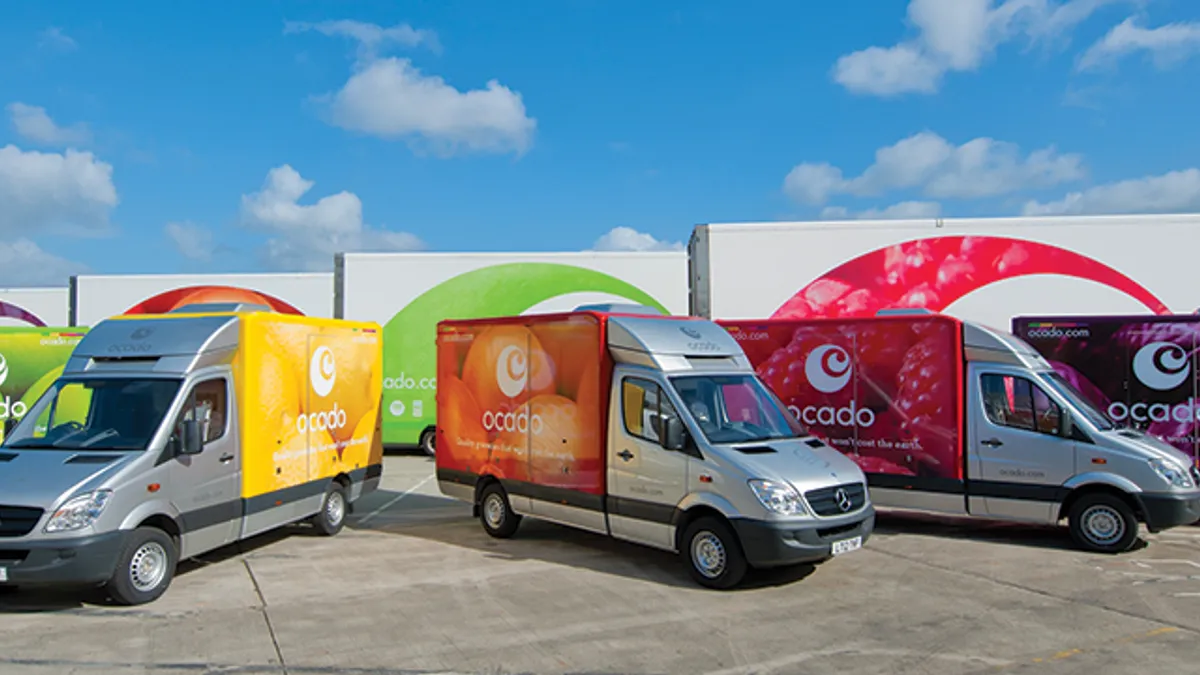Dive Brief:
- Ocado, the U.K.-based e-commerce provider, says it’s getting more inquiries from U.S. retailers regarding possible partnerships following Amazon’s acquisition offer for Whole Foods, according to Reuters.
- Industry analysts are divided over the long-term viability of Ocado, which currently controls 1.3% of the British grocery market. Some believe the company’s warehouse distribution system is the future of e-commerce, while others believe the system is too expensive to scale profitability.
- Ocado currently has distribution agreements with British retailers Waitrose and Morrisons. Some experts believe Amazon’s recent acquisition indicates Ocado, too, will need to acquire a grocery chain to grow. But chief executive Tim Steiner rejected this idea during a recent earnings call. "I think they [Amazon] just bought a player in the U.S. that has a very high quality recognized brand name and recognized sourcing," he said.
Dive Insight:
Last month, Ocado inked its first deal with a yet-to-be-announced European retailer, marking a long-awaited expansion for the company outside the U.K. It is, according to Steiner, the “first of many” moves abroad Ocado has planned.
A U.S. move remains very tantalizing for retailers and industry observers, particularly in the wake of the Amazon-Whole Foods deal. That’s because Ocado operates a different model from the one most American grocers employ — and it’s one that’s been battle-tested in a more mature, fiercely competitive British online grocery market.
Ocado doesn’t operate physical stores, but rather a collection of large, mostly automated warehouses where products are picked, packed and sent out to customers. In addition to its own product selection, the company partners with retailers, giving them access to Ocado’s distribution capabilities as well as its software and technology systems. Waitrose, an upscale retailer, stocks its products in Ocado’s warehouses and lets the company handle order processing and distribution. Morrisons, a more traditional grocery chain, has a distribution agreement that lets online orders go out from its store locations.
Like Amazon, Ocado is viewed throughout the industry as a logistics expert and data-mining guru. Its expertise could make for an effective counterattack to Amazon’s much-anticipated e-commerce ramp up through Whole Foods.
Moreover, Ocado’s model could address two glaring problems U.S. retailers are facing right now with their e-commerce operations: scalability and profitability. Many grocers, whether on their own or through Instacart, Shipt and other services, are using their stores as warehouses for workers to gather and pack orders. That works fine on a limited scale, according to experts interviewed by Food Dive. However, as orders increase, out-of-stocks do too, and workers begin to disrupt the store experience. The model simply isn’t scalable. Also, stores are not optimized for online order gathering, while Ocado’s warehouses are.
Profitability has remained frustratingly elusive for retailers, given how complex and capital-intensive e-commerce is. Being the first e-commerce service to a particular market can net new customers, but for most grocers the service has simply become the cost of doing business.
There’s certainly no guarantee that Ocado would effectively address these problems. And it remains unclear how, exactly, Ocado would expand in the U.S. But given its expertise and reputation for efficiency, it’s an understandably attractive partner for retailers. A tech-first, warehouse-focused e-commerce model isn’t a guaranteed solution to grocers’ e-commerce woes, but right now it seems to be the clearest evolution of the business.









